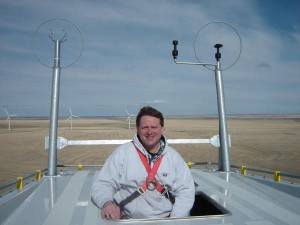January 24, 2012 | Engineering + Technology, Wind Plant Optimization
Inspired by Justin Wheating’s last post, I’m focusing this month on something we can control.
We can either feel down-in- the-mouth about policy uncertainty, or we can swallow that bitter pill (for now) and focus on lowering the cost of production and using our current assets more efficiently. Hence my interview with Larry Jacobs, long-time employee of NRG Systems who now serves as our product manager for Turbine Health Monitoring. In between trade shows, alpha installs, and planning meetings, Larry sat down with me to chat about our latest venture into condition monitoring for wind turbines.
Q: What is condition monitoring and how are these systems currently being used in the wind industry?
A: People in the [Operations and Maintenance] space have different interpretations of what condition monitoring is. Basically, it’s a system that allows wind farm owners and operators to monitor a turbine’s drive-train remotely and schedule maintenance as needed. Simple systems might detect oil debris or temperature changes, while full-blown systems could measure vibrations of all drive-train components and the blades.
Ours is a health monitoring system because it predicts when components will go bad and provides end users readily understandable, actionable data. With other condition-monitoring systems O&M professionals have to rely on diagnostic engineering support to understand what their system is telling them, which can add significant cost.
Q: NRG Systems has always focused on measurement. Why enter this new space?
A: First off, condition monitoring is another form of measurement. It’s just focused on the health of a turbine versus environmental conditions. Second, we’ve got to find a way, as an industry, to get more power out of the machines we currently have in the ground. This means running them and maintaining them more efficiently. This is particularly important with $40 billion in assets coming off warranty in the U.S. Third, NRG Systems has strong connections with the aerospace industry. Based on the talent that has come on board, we’ve been able to borrow technology – like condition monitoring for helicopters – and apply it to the wind industry.
Q: Wind turbines and helicopters are similar? How?
A: They both have rotating parts: blades, bearings and gears. And they both operate in similar, somewhat violent conditions. Even though a turbine blade might have an RPM of 15, and a helicopter blade an RPM of 250, they both place a tremendous amount of torque on the system. In the aerospace industry, condition-monitoring systems are mandatory because the risks to human life and equipment cost are so high. While the human risk with wind energy is negligible, equipment costs are quite significant, especially when catastrophic failures occur. An effective condition- monitoring system can help mitigate these risks.
Q: How common are condition-monitoring systems for wind turbines?
A: Right now about 20-25% of the turbine installed base is outfitted with condition-monitoring systems, most often sold with the turbine and provided by the OEM at time of sale. Wind farm operators that don’t use them either run turbines to failure or do regular inspections. Using a condition-monitoring system versus not using one is the difference between doing periodic inspections – and guessing when components might fail – versus monitoring the system on a continual basis.
Q: When looking at condition monitoring, what questions should owner/operators ask themselves?
A: They should ask themselves, does the system provide actionable information in a timely manner? They need to know the current health of all the components in the drive-train and when those components might go bad. From there, they can schedule future maintenance actions in the most cost effective manner. The forward-looking estimates of component life are key. The longer the planning horizon, the more opportunities for cost savings.
They should also ask themselves about the overall value of the system, not just its list price. This means weighing the quality of the information, usability of the system and reliability of the data. It means having confidence in the information coming from the condition- monitoring system, such as “do nothing” or “plan maintenance.” These signals should be transparent and easy to understand.
It’s like buying the service manual when you buy a new car. Even if I never perform my own maintenance, I like having access to information and being able to drill down into the details. What can I say? I’m an engineer. I like data.

